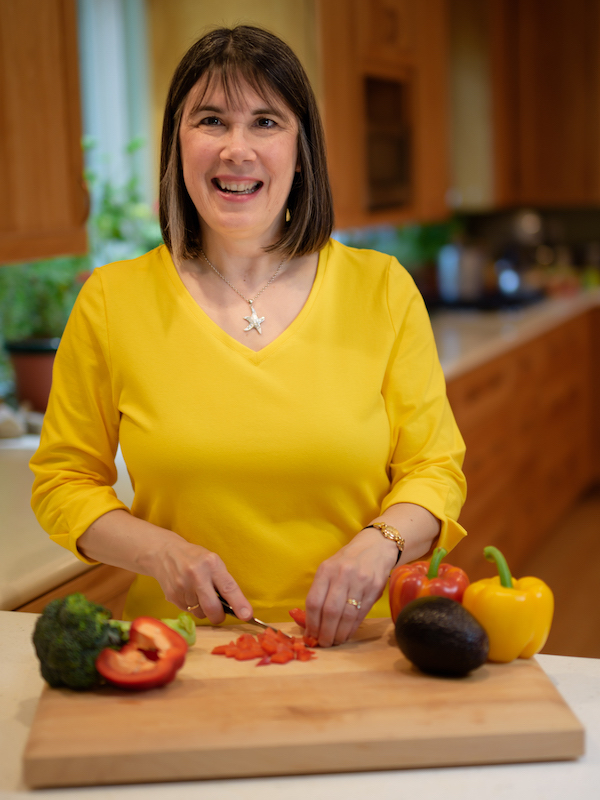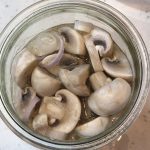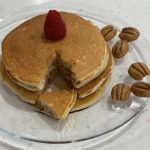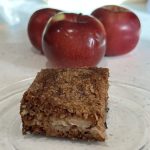
Here is the transcript of the episode:
Welcome to the sensitive kitchen. Where home cooks are inspired to “Cook to Enable Those You Love to Flourish.” I’m Cindy Sullivan, registered dietitian, passionate nutrition, educator, and accomplished home cook. Whether you’re changing, how you cook for food sensitivities, allergies, intolerances, or just trying to eat healthier on a budget. You’re in the right place.
Most episodes I will share favorite recipes as well as modification tips and nutrition benefits. Occasionally I’ll have a guest or special episode like modifying holiday favorites. My favorite foods, they’re raspberries and homemade chocolate chip cookies. My latest cooking project was long fermented sourdough bread.
We’re here today to talk about whole wheat pumpkin bread – moist, delicious, and easy. I just sent a loaf to each of my college students and it traveled well. They were delighted to receive it.
This quick bread would be at home for dessert, breakfast or a snack. I always make two loaves like the recipe below so that I have some in the freezer, but you could easily half the recipe using a small can of pumpkin instead of a large one. My kids insist on mini chocolate chips being added, but I love it with lemon glaze too.
Let’s start with a few nutrition tidbits about this recipe. Pumpkin is rich in beta carotene, which is both an antioxidant in your body and a vitamin A precursor. An antioxidant helps fight inflammation caused by free radicals in your body, which can also help fight disease. Canned pumpkin contains about seven grams of fiber per cup for only about 80 calories. It’s also a great source of potassium.
Whole Wheat. This is a part-whole wheat recipe. You can easily substitute all whole wheat, especially if you’re using a white whole wheat flour. White whole wheat flour is often preferred by non-whole wheat lovers because of its milder flavor. But don’t worry. You’re still getting all the benefits of whole wheat.
Let’s talk about substituting to make this gluten-free. A one-to-one substitution with a gluten-free baking mix should work fine, but I haven’t tried it. So we might as well address the elephant in the room. Why do I not bake more gluten free if my husband reacts to wheat?
Several reasons, actually. Now, first of all, I have to say that he does not have celiac disease and he is not allergic to wheat. He’s just sensitive to it.
Most of the flour substitutes that I found are very refined grains. They’re using starches and gums to replace the protein or the gluten in wheat. And I would rather use whole grains instead of avoiding a protein that doesn’t bother most of us and does not bother my husband in moderation.
The benefits of whole grains are great. An excellent article in Today’s Dietitian way back from May, 2013, summarize the benefits of whole grains like this, (quote)
“Overall studies show that consuming two to three servings of whole grain foods per day will provide health benefits, possibly reducing the risk of cardiovascular disease, hypertension, type two diabetes, colon cancer, and obesity in prospective studies. (Those are the ones look forward. People aren’t sick yet in prospective studies.) Several whole grain components can have positive effect on gastrointestinal health, including fiber, oligosaccharides, phytochemicals, antioxidant vitamins and minerals. The fiber has been studied most extensively.” (End of quote.)
Now don’t get me wrong. If you have celiac disease, you must avoid all wheat. If you’re on an elimination diet, or in the process of adding foods back, follow it strictly. If you’re allergic to wheat avoid it at all costs. If you’re in a three to six month trial without wheat avoid it.
However, if you’re sensitive or intolerant to wheat, look carefully at your choices. Or maybe you’re just doing it because everyone else is? Why are you avoiding wheat? Does it bother you in small amounts? Does whole wheat bother you the same as refined wheat? What about bleached versus unbleached flour?
Did you know that many people believe it’s the glysophate or the Roundup that is sprayed on the wheat in the United States before it’s harvested, that people are actually reacting to and not the gluten. One line of evidence for this idea is that many Americans find that they can eat bread and pasta with no problems in Europe. Now this is just anecdotal evidence. This doesn’t prove anything. It’s just interesting evidence.
The other problem is you cannot just rely on organic wheat to solve this Roundup problem. When you compare organic versus conventionally grown wheat for glycosphate and other pesticide levels, they’re virtually identical. That’s why I save my money and purchase regular flour; $4 a bag versus $9. A bag makes a big difference in my budget.
If you find you feel better without wheat in your diet, I fully support you, but if you’re avoiding it just because everyone else is consider adding some whole wheat back into your diet. When you are avoiding multiple foods already, the more variety you can put back into your diet, the better, and if your body has calmed down enough and you’re not reacting to everything, perhaps try a small amount of whole wheat again. It will make your life easier.
But besides making your life easier, I’m actually concerned about nutrient intake here. For many years, nutrition professionals have not been concerned about most Americans B vitamin intake. However, I started to notice a trend in my students’ food records. In recent years, I had quite a few students who were very low in B vitamin intake. And when I looked more closely, these students had drastically reduced their whole grain intake or actually all grains, not just whole grains.
Now take these observations as such. They’re just observations, not from evidence but observations, but it’s interesting to me that this was a fairly consistent finding in my students’ food records.
Also in the United States, we added folic acid, a B vitamin to refine grains to help prevent birth defects. Folic acid is a B-vitamin that many women in their childbearing years don’t get enough of so it was added to flour. So if you’re avoiding wheat, be sure to consume good sources of folic acid, leafy greens, asparagus, legumes daily.
Okay off my soap box. I just want to make sure that you’re avoiding it for the right reasons. And if you’re just intolerant, every couple of years, you might want to try it again to see how you feel. And I don’t mean cheating on birthday cake. You might not feel good after that regardless.
And in my household, we eat without wheat or gluten much of the time. So I have lots of recipes that are naturally gluten-free. Don’t worry.
Now let’s get back to substitutions
For the eggs in this recipe, I would try a flax egg. For a flax egg, you take one tablespoon of ground flax meal mixed with three tablespoons of water per egg. And you let it sit for about five minutes or so. So the soluble fiber can form sort of a gel, and that’s what helps give it an egg properties in this recipe.
This recipe doesn’t need the extra moisture that applesauce would give, but it certainly shouldn’t hurt either if you prefer to use an applesauce to substitute for your egg
Use, whatever oil you prefer. I use canola oil for the omega-3 fats it contains, which gives it a better ratio of Omega six to Omega three fats, than most liquid oils.
Spices – here, you get to really personalize this recipe. We just add a small amount of cinnamon because my husband is sensitive. However, I would like to add more cinnamon and ginger, he doesn’t eat ginger hardly at all. Crystallized ginger would be awesome in this recipe. If you’re a ginger fan.
In terms of instructions, as I said, this is actually a really easy recipe. It’s quick; it’s even quicker. If you happen to have a stand mixer.
Combine the eggs and the oil and mix them well. Add the pumpkin and the sugar and stir until it’s combined.
I usually combine the dry ingredients in a separate bowl with a whisk to make sure the spices and leavening will be evenly distributed, but it’s really not necessary. I have pictures on the blog both ways. So you mix the dry ingredients into the wet ingredients in two or three batches, add the chocolate chips. if you’re using them.
Grease your pans and bake.
Now, if you want to add a lemon glaze to this recipe, perhaps instead of the chocolate chips, I don’t really recommend both, but that’s up to you, while the bread bakes. mix the confectioner’s sugar. (And, I do sift my confectioner’s sugar so I don’t get lumps in it) with lemon juice,the lemon rind or lemon oil. Mix thoroughly.
And just wait until the bread comes out of the oven. When the bread comes out of the oven, you want to put that lemon glaze over it fairly soon while it’s still hot and still in the pan. This will ensure that that lemon begins to soak in and really penetrate the pumpkin bread. It’s yummy.
When iIt’s cool, it’ll just pop right out of the pan for you, as long as you’ve greased it well.
Try to wait until it’s cool to cut it. Like all quick breads, it’s better the second day. Wrap it well. Freeze it or store at room temperature.
When I freeze it, I usually slice it before I freeze it. So I slice it, wrap it in plastic wrap, put it in a freezer bag, label it and store it. I have also sliced it and put the individual sheets on a cookie sheet, excuse me, the individual slices on a cookie sheet, either with parchment underneath or a baking mat underneath. So it’s easier to pull off the sheet and then put them in a freezer bag and freeze them.
Let me know on my website, foodsensitivitykitchen.com if you try this; how you modify it; what spices you use. It’s a really quick, easy, wonderful recipe, especially for this time of year. When we think a lot of pumpkins, but we eat it almost year round in my house. I must admit.
So for the recipe, go to foodsensitivitykitchen.com/zero zero five, or look for whole wheat, pumpkin bread. And the recipe is there. Thanks so much for listening. If you haven’t yet click subscribe, and I will be back next week with a new recipe. Have a wonderful day. Bye-bye.




